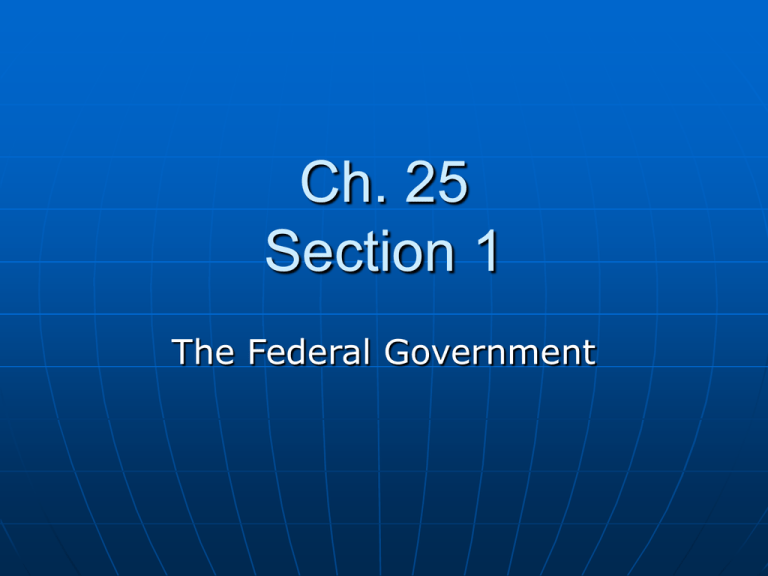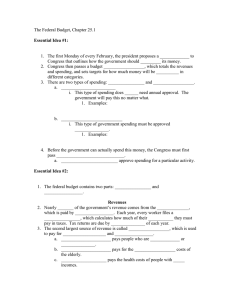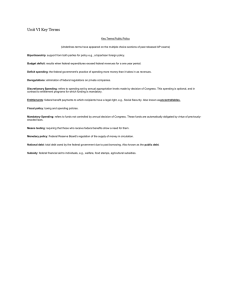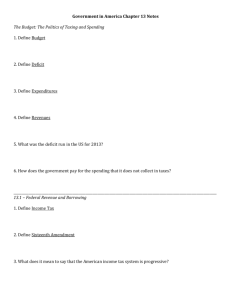Ch. 25 Section 1 The Federal Government
advertisement

Ch. 25 Section 1 The Federal Government Preparing the Budget Each year, the President and Congress are responsible for creating the federal budget – a plan for how the government will raise and spend money. A budget will cover a fiscal year – a 12 month period that may or may not match the calendar year. The government’s budget actually begins Oct. 1 and ends Sept. 30 of the following year calendar year. Preparing the Budget (cont.) By law, the President must present a budget (an outline of where government should spend its money) to Congress by the first Monday in February The date can be pushed back for an incoming President Ex. 2008 McCain or Obama Preparing the Budget (cont.) When the budget is presented, Congress then passes a budget resolution – a document which totals revenues and spending and sets targets for how much will be spent in various categories These categories are broke down into 2 types: mandatory spending discretionary spending Preparing the Budget (cont.) Mandatory spending – spending that does not need annual approval; has to be paid regardless Ex. Social Security, interest payments on the national debt Discretionary spending – spending that must be authorized each year. Ex. Space exploration, national defense, agriculture, etc. Preparing the Budget (cont.) The next step before the government can actually spend money is: Congress must pass an appropriations bill – legislation which authorizes spending for a particular activity Congress splits all discretionary spending into 13 separate bills which follow the normal process through the House and then the Senate and then finally signed by the President. Preparing the Budget (cont.) Appropriation bills must be finalized by Sept. 15. If not, Congress can agree to a temporary extension until the bill becomes a law. Revenues and Expenditures The 2 main parts of a federal budget are revenues and expenditures Nearly half of the federal government’s revenue (money it brings in) comes from individual income tax. 45% comes from individual income tax Revenues (cont.) Part of a worker’s paycheck is withheld every payday. At the end of the year, workers file a tax return that calculates the income tax the worker owes. If too much is was withheld, the worker will receive a refund; if too little was withheld, the worker must pay the difference. Revenues (cont.) 36% of federal revenues come from Payroll Taxes deducted from a worker’s paycheck to fund Social Security and Medicare. Social Security – a program that provides money to people who are retired or disabled. Medicare – program that pays some health care costs of elderly people. Revenues (cont.) 11% of federal revenue comes from corporate income taxes 3.5% comes from Excise Tax which is added on to such items such as gasoline, tobacco, and alcohol. Also cell phone service and legal gambling Also referred to as a vice tax. Revenues (cont.) The federal government also collects an estate tax on wealth passed on to a person’s heirs. Charges are also added to certain gifts Forms of Taxation Taxes in the United States are classified as proportional, progressive, and regressive. A proportional tax takes the same % of income from everyone regardless of how much he or she earns At 10% on income: $10,000 = $1,000 100,000 = $ 10,000 Forms of Taxation (cont.) With a progressive tax, the tax rate increases as income increases The higher the income, the larger the % of income paid as taxes http://www.moneychimp.com/features/tax_brackets.htm Forms of Taxation (cont.) With a regressive tax, it is the opposite of a progressive tax The % you pay goes down as you make more money The higher the income, the smaller the % of income is paid to taxes. Ex. Gasoline tax Expenditures Social Security is the largest federal expenditure or spending category. $.21 of every dollar is spent on Social Security Our population continues to get older so the amount of money we spend on this program is sure to increase. Expenditures (cont.) National Defense is second when it comes to federal expenditures. $.17 of every dollar is spent on this country and its protection During times of conflict, spending for this category increases Expenditures (cont.) $.09 -$.10 of every dollar is spent to pay down the interest on the national debt. The amount paid depends on the size of the debt and the interest rates at the time. On top of this the government spends billions on education, highways, and natural resources.



